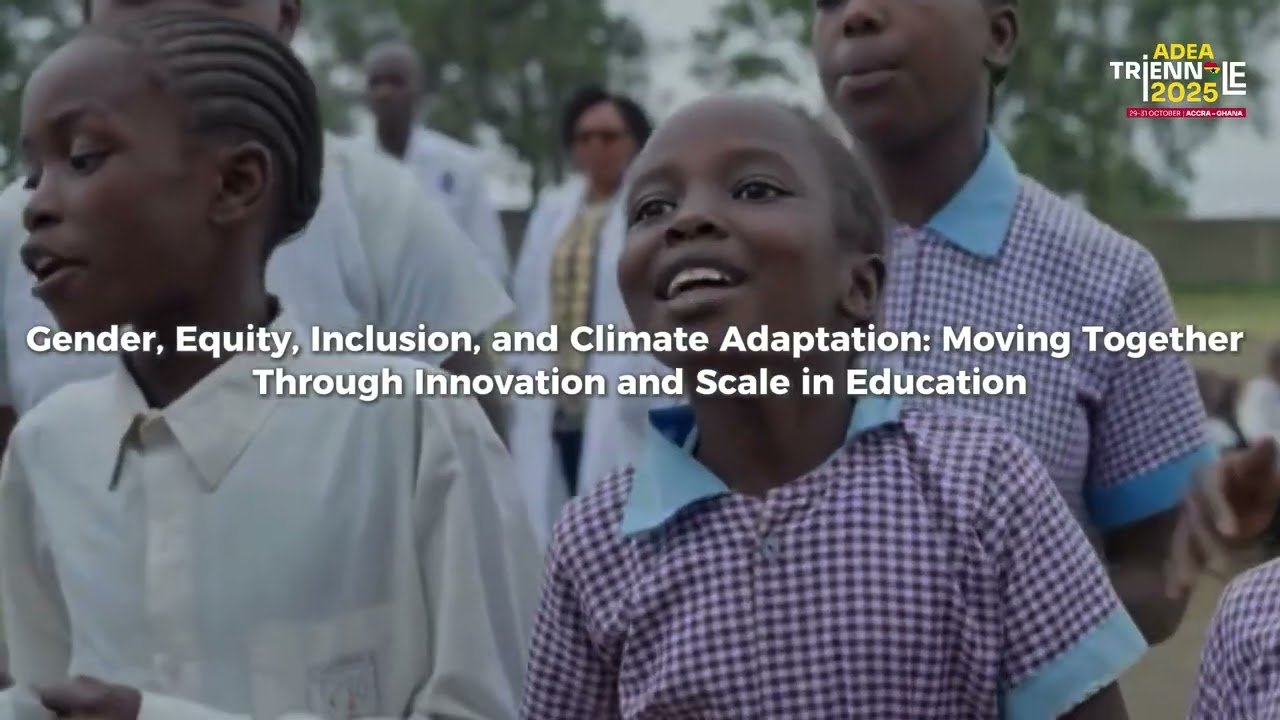Sous-thème 8
Genre, équité, inclusion et adaptation au changement climatique : aller de l'avant grâce à l'innovation et à la mise à l'échelle dans le domaine de l'éducation
Le chemin vers la promotion du genre, de l'équité et de l'inclusion en Afrique a été long et sinueux, avec des tronçons faciles et d'autres plus difficiles. Ce sous-thème examine ce que font (ou ont fait) les gouvernements africains, réfléchit aux lacunes et explore ce qui peut être fait différemment en termes de stratégies innovantes.
Ce qui fonctionne
À l'heure actuelle, de nombreux pays ont mis en place des politiques éducatives et des réformes juridiques favorables à l'égalité des sexes (par exemple, le projet de loi sur la discrimination positive au Ghana, l'enseignement primaire gratuit avec des dispositions en matière d'équité au Kenya). Le FAWE travaille avec les pays pour mettre en œuvre le cadre de la pédagogie sensible au genre (GRP), une approche pédagogique qui intègre la sensibilité au genre dans la planification des cours, les méthodes d'enseignement et la gestion de la classe. Grâce à ce cadre, les enseignants sont formés à utiliser un langage inclusif, à encourager la participation égale et à lutter contre les stéréotypes sexistes, ce qui se traduit par une augmentation du taux de rétention et de participation des filles. L'Union africaine (UA), par l'intermédiaire du CIEFFA et de l'initiative « Gender at the Centre » (GCI), a fourni un soutien de haut niveau et des plateformes pour suivre les progrès réalisés. Des pays tels que le Kenya et le Ghana ont mis en place des politiques nationales et des pratiques au niveau des écoles qui intègrent les enfants handicapés dans les écoles ordinaires. Ces pratiques comprennent des infrastructures accessibles, des technologies d'assistance, des plans d'éducation individualisés (IEP) et la formation des enseignants, ce qui se traduit par une amélioration du taux de scolarisation et de rétention des enfants handicapés.
Il existe des programmes en cours qui offrent une seconde chance à l'éducation aux filles, par exemple au Nigeria (Nord-Est) et au Mali. Il s'agit de programmes d'apprentissage accéléré destinés aux adolescentes touchées par les conflits ou les mariages précoces, mis en œuvre par le programme Girls for Girls de l'UNICEF, l'UNGEI et des ONG locales. Cette initiative a permis la réintégration de milliers de filles dans l'enseignement formel ou la formation professionnelle, améliorant ainsi leur autonomisation économique et réduisant leur vulnérabilité à la violence. Des programmes d'alimentation scolaire locaux sont également mis en place dans plusieurs pays africains. Les programmes de repas scolaires et d'assainissement en Éthiopie et en Zambie contribuent à maintenir les filles à l'école en leur fournissant des repas scolaires, des produits d'hygiène menstruelle et des installations sanitaires séparées pour les filles. Mise en œuvre par le PAM, Save the Children et les autorités éducatives locales, cette initiative a permis d'augmenter la fréquentation et les résultats scolaires des filles, en particulier pendant leurs règles, et d'améliorer le taux de scolarisation global.
L'Ouganda dispose de l'une des plus importantes initiatives en matière d'éducation des réfugiés et des communautés d'accueil. Il s'agit d'un programme éducatif intégré dans le cadre duquel les enfants réfugiés apprennent aux côtés des communautés d'accueil. Avec le soutien de partenaires tels que le HCR et Education Cannot Wait, cette initiative favorise l'inclusion, la cohésion sociale et la coexistence pacifique entre les communautés. Parmi les autres points positifs, on peut citer la planification fondée sur des données grâce à des investissements accrus dans les SIGE et les données ventilées par sexe afin d'améliorer la planification, ainsi que des programmes ciblés tels que les transferts monétaires conditionnels pour les filles (par exemple au Nigéria), les kits sanitaires et les installations WASH (Zambie, Éthiopie) et les initiatives pour la sécurité dans les écoles dans les États sortant d'un conflit.
Les pays africains répondent à l'adaptation au changement climatique par le biais de leurs systèmes éducatifs de diverses manières, notamment par le soutien politique et institutionnel, l'élaboration et l'intégration de programmes scolaires, la recherche, la formation des enseignants et le renforcement des capacités, la technologie et l'innovation, l'éducation communautaire et informelle, et les partenariats. En ce qui concerne le soutien politique et institutionnel, des pays comme l'Éthiopie et le Rwanda intègrent la résilience climatique dans leurs stratégies nationales en matière d'éducation. L'Union africaine et l'UNESCO soutiennent également des cadres pour l'intégration de l'éducation au climat à travers le continent. En ce qui concerne l'élaboration et l'intégration des programmes scolaires, des programmes axés sur le climat existent dans des pays comme le Kenya, l'Afrique du Sud et le Nigeria, qui intègrent l'éducation au changement climatique dans les matières scientifiques, géographiques et agricoles aux niveaux primaire et secondaire. L'intégration des connaissances autochtones se poursuit également grâce à des programmes éducatifs qui intègrent les connaissances environnementales traditionnelles (par exemple, l'agriculture durable, la conservation de l'eau) dans les programmes scolaires. Les pays ont également adopté l'EFTP verte grâce à des programmes qui dotent les étudiants de compétences pratiques dans le domaine de l'environnement, telles que l'installation de panneaux solaires, l'agriculture durable et l'éco-construction.
Où se situent les lacunes et que peut-on faire différemment ?
Une lacune majeure réside dans la faiblesse de la mise en œuvre. Des politiques solides existent, mais elles manquent souvent de financement, de formation des enseignants et de systèmes de suivi. Les stéréotypes et les pratiques culturelles persistants, tels que le mariage des enfants et la priorité accordée à l'éducation des garçons, continuent d'entraver les progrès. L'intersectionnalité n'est pas suffisamment prise en compte, les efforts négligeant souvent les apprenants handicapés, les réfugiés, les minorités ethniques et les communautés mobiles. En raison de la fracture entre les zones urbaines et rurales, les régions reculées sont les plus touchées par le manque d'enseignantes, la médiocrité des infrastructures et les problèmes de sécurité.
Les pays doivent intégrer l'EGI dans toutes leurs politiques et tous leurs budgets en matière d'éducation, afin que le genre et l'inclusion soient au cœur de tous les plans et politiques du secteur de l'éducation. Il est utile d'investir dans le dernier kilomètre, en donnant la priorité aux apprenants ruraux, déplacés et défavorisés grâce à des centres d'apprentissage communautaires, des écoles mobiles et des outils numériques accessibles. Il convient de renforcer la gouvernance scolaire en donnant la parole aux communautés et de soutenir les enseignantes et les femmes leaders en leur offrant des incitations, des bourses et des programmes de leadership afin d'augmenter le nombre de femmes enseignantes dans les communautés défavorisées. En matière d'adaptation au changement climatique, il convient d'élaborer des programmes scolaires axés sur le climat dans les écoles primaires et secondaires, qui intègrent une éducation climatique localisée dans les programmes nationaux (par exemple, la résilience à la sécheresse au Sahel, la gestion des inondations en Afrique de l'Ouest). Il faut également mettre en place des programmes communautaires de sensibilisation au climat et intégrer les connaissances autochtones et l'éducation à la résilience climatique en documentant et en enseignant les connaissances écologiques autochtones (par exemple, les méthodes traditionnelles de prévision météorologique, le traitement des sols à base de plantes) et en combinant science et tradition dans les programmes d'éducation à l'adaptation au changement climatique.
Autres stratégies innovantes à envisager :
- Plateformes EdTech sensibles au genre : développer des outils mobiles adaptés aux horaires et aux contextes d'apprentissage des filles, en particulier dans les zones rurales.
- Certification « Safe to Learn » : un système qui récompense les écoles qui respectent les normes en matière de sécurité, de genre et d'inclusion.
- Pôles d'inclusion dans les écoles normales : utiliser des laboratoires d'innovation et des formations immersives (par exemple, des simulations en réalité virtuelle) pour former les enseignants à l'éducation inclusive.
- Identités numériques + portefeuilles d'apprentissage : suivre l'assiduité et les droits des élèves, en particulier ceux des réfugiés et des enfants nomades.
- Tableaux de bord sur l'égalité des sexes : lier le financement et la responsabilité aux résultats réels en matière d'égalité des sexes, et pas seulement aux engagements.
- EFTP pour la résilience climatique : se spécialiser dans l'agriculture intelligente face au climat, les systèmes d'énergie renouvelable, la gestion de l'eau et la construction écologique.
- Pôles d'innovation et centres de recherche universitaires : créer des laboratoires d'innovation climatique dans les universités afin de favoriser les solutions locales (par exemple, cultures résistantes à la sécheresse, micro-irrigation).
- Éducation des femmes et des filles : développer la formation au leadership climatique pour les filles, en particulier dans les communautés pastorales et agricoles.
Les gouvernements africains ont fait des progrès importants dans la promotion de l'égalité des sexes, de l'équité et de l'inclusion dans l'éducation. Cependant, le rythme et l'ampleur actuels de la mise en œuvre ne sont pas suffisants. Ce qu'il faut maintenant, c'est un changement : passer d'une approche qui considère l'IGÉ comme un « complément » à une approche qui l'intègre comme une norme fondamentale de qualité et de justice dans tous les systèmes éducatifs nationaux. C'est l'un des aspects que ce sous-thème abordera.

